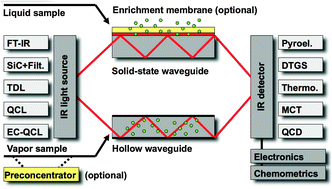You wouldn’t think it, but mid-infrared (IR) optical sensing technologies and I have a lot in common. I know. Unlikely as it seems that I – a small, Scottish, Beyoncé-wannabe – can overlap with a spectral regime known for its ability to directly characterise the structure of molecular species with finger print specificity, it is true. We are both children of the 80s and we are both suffering from ‘middle (child) syndrome’. As such, our potential often goes unnoticed and we are often overlooked by our bookends (visible and near IR in mid IR’s case; the 25-year-old ‘baby’ of the family and the first-born in my case). In this recent Chem Soc Rev article, Boris Mizaikoff at the University of Ulm in Germany champions the case for mid-IR sensors.
Miziakoff discusses how and why the field of mid-IR sensing has matured more slowly than visible and near IR technologies, as it requires a variety of optical components and materials compatible with its spectral range, ultimately making it more costly than near IR. However, mid-IR offers unrivalled advantages in the level of molecular specificity, and discrimination and quantification of the components of complex mixtures.
Leading us through the developments in mid-IR sensing devices, Mizaikoff demonstrates that widespread use of these technologies is not only possible, but could enhance many emerging scientific concepts, together with practical applications such as security and surveillance, the monitoring of water quality, as well as use in the medical field.
As Mizaikoff writes, the future is promising for this sensing concept with its potential impact on the fields of environmental analysis and bioanalytics.
Read this HOT Chem Soc Rev article now in full:
Waveguide-enhanced mid-infrared chem/bio sensors
Boris Mizaikoff
Chem. Soc. Rev., 2013, Advance Article
DOI: 10.1039/C3CS60173K, Review Article
Sarah Brown is a guest web-writer for Chem Soc Rev. Sarah hung up her lab coat after finishing her PhD and post-doctorate in nanotechnology for diagnostics and therapeutics, and now works in scientific publishing. When not trying to explain science through ridiculous analogies, you can often find her crocheting, baking or climbing, but not all at once. All views are her own.











